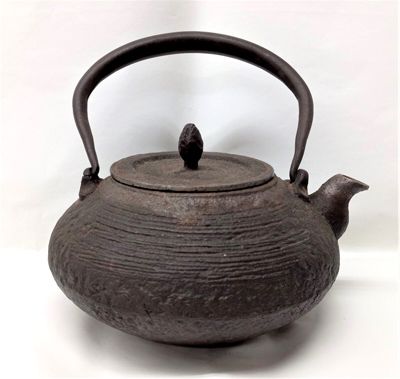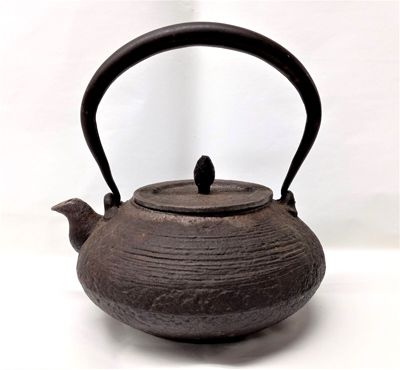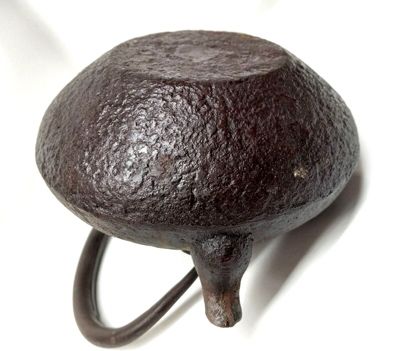Hi,
I'm very new to Japanese tea drinking and want to get an good tea pot, preferably old. I have a small quirky antique shop near me which occasionally sells cast iron Japanese teapots - can anyone give me advice about what to look for and what to avoid? Obviously I don't want a pot that will spoil the tea - and be harmful to me!
Any help much appreciated.
Re: Old iron teapot
If it's glazed inside, make sure the glaze is still good, otherwise it might not be safe. Glazed teapots are generally low quality. If it's an unglazed teapot, those are actually often times high quality, but need to see a picture to confirm.
Loving the stories behind every leaf.
Re: Old iron teapot
It sounds like you are looking for an antique tetsubin (special, traditional type of cast iron Japanese kettle) you will want to look for several things and you will need to know how to care for it. I can help!
What to Look For
Look for all cast iron, inside and out, no infuser screen, no enamel lining
An old tetsubin that has had years of use will develop a scaly or rusty looking surface inside and an orange peel, bumpy surface on the exterior. See the pictures of my tetsubin pictures below. Tetsubin are individually made and after two or three are produced, the mold is destroyed, and has to be remade again. That is why they are expensive, but with proper care, they will last a lifetime, so think of it as an investment. Rust is not harmful, and in fact, it is cultivated in these old kettles for the unique flavor it adds to the tea! There is an old saying in Japan that the best tea comes from an old rusty pot! Tetsubin are works of art and some of them are signed. On the hobnail type of tetsubin, the more bumps the better, because each one is placed in the mold by hand. They can range from about $100 to over a thousand. Most will be between $100 and $300ish.
Taking Care of a Tetsubin
When you get your tetsubin home, rinse it with water only. Boil a pot of water in it, pour it out and repeat two to four times, or however many you need to have clear water in it. You're removing impurities like dust and dirt that may have accumulated. Never put anything but water! No soap, no oil, no tea. It is only for boiling water and pouring it over the tea leaves in your cup or tea bowl! You can use an electric, gas or other type of burner, including an open fire to heat your tetsubin. Use a cloth to lift your tetsubin's lid and handle, they get hot! Never pour cold water in a hot tetsubin, they can crack. Don't let it sit empty on a heated burner. Dry your tetsubin thoroughly, so that it does not rust. You want a thin layer of scale, not full on corrosion. To dry it, just turn the burner off and let the tetsubin sit on the cooling burner while you enjoy your tea. When the burner is cool, the tetsubin is clean and dry and ready for your next bowl of tea!




What to Look For
Look for all cast iron, inside and out, no infuser screen, no enamel lining
An old tetsubin that has had years of use will develop a scaly or rusty looking surface inside and an orange peel, bumpy surface on the exterior. See the pictures of my tetsubin pictures below. Tetsubin are individually made and after two or three are produced, the mold is destroyed, and has to be remade again. That is why they are expensive, but with proper care, they will last a lifetime, so think of it as an investment. Rust is not harmful, and in fact, it is cultivated in these old kettles for the unique flavor it adds to the tea! There is an old saying in Japan that the best tea comes from an old rusty pot! Tetsubin are works of art and some of them are signed. On the hobnail type of tetsubin, the more bumps the better, because each one is placed in the mold by hand. They can range from about $100 to over a thousand. Most will be between $100 and $300ish.
Taking Care of a Tetsubin
When you get your tetsubin home, rinse it with water only. Boil a pot of water in it, pour it out and repeat two to four times, or however many you need to have clear water in it. You're removing impurities like dust and dirt that may have accumulated. Never put anything but water! No soap, no oil, no tea. It is only for boiling water and pouring it over the tea leaves in your cup or tea bowl! You can use an electric, gas or other type of burner, including an open fire to heat your tetsubin. Use a cloth to lift your tetsubin's lid and handle, they get hot! Never pour cold water in a hot tetsubin, they can crack. Don't let it sit empty on a heated burner. Dry your tetsubin thoroughly, so that it does not rust. You want a thin layer of scale, not full on corrosion. To dry it, just turn the burner off and let the tetsubin sit on the cooling burner while you enjoy your tea. When the burner is cool, the tetsubin is clean and dry and ready for your next bowl of tea!




brendanxx wrote: Hi,
I'm very new to Japanese tea drinking and want to get an good tea pot, preferably old. I have a small quirky antique shop near me which occasionally sells cast iron Japanese teapots - can anyone give me advice about what to look for and what to avoid? Obviously I don't want a pot that will spoil the tea - and be harmful to me!
Any help much appreciated.